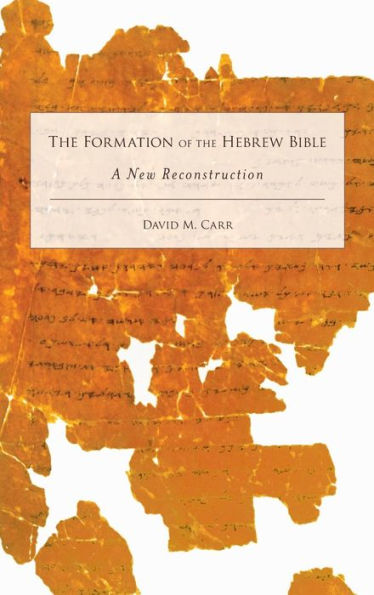The Formation of the Hebrew Bible: A New Reconstruction
In The Formation of the Hebrew Bible David Carr rethinks both the methods and historical orientation points for research into the growth of the Hebrew Bible into its present form. Building on his prior work, Writing on the Tablet of the Heart (Oxford, 2005), he explores both the possibilities and limits of reconstruction of pre-stages of the Bible. The method he advocates is a ''methodologically modest'' investigation of those pre-stages, utilizing criteria and models derived from his survey of documented examples of textual revision in the Ancient Near East. The result is a new picture of the formation of the Hebrew Bible, with insights on the initial emergence of Hebrew literary textuality, the development of the first Hexateuch, and the final formation of the Hebrew Bible.
Where some have advocated dating the bulk of the Hebrew Bible in a single period, whether relatively early (Neo-Assyrian) or late (Persian or Hellenistic), Carr uncovers specific evidence that the Hebrew Bible contains texts dating across Israelite history, even the early pre-exilic period (10th-9th centuries). He traces the impact of Neo-Assyrian imperialism on eighth and seventh century Israelite textuality. He uses studies of collective trauma to identify marks of the reshaping and collection of traditions in response to the destruction of Jerusalem and Babylonian exile. He develops a picture of varied Priestly reshaping of narrative and prophetic traditions in the Second Temple period, including the move toward eschatological and apocalyptic themes and genres. And he uses manuscript evidence from Qumran and the Septuagint to find clues to the final literary shaping of the proto-Masoretic text, likely under the Hasmonean monarchy.
1111444380
Where some have advocated dating the bulk of the Hebrew Bible in a single period, whether relatively early (Neo-Assyrian) or late (Persian or Hellenistic), Carr uncovers specific evidence that the Hebrew Bible contains texts dating across Israelite history, even the early pre-exilic period (10th-9th centuries). He traces the impact of Neo-Assyrian imperialism on eighth and seventh century Israelite textuality. He uses studies of collective trauma to identify marks of the reshaping and collection of traditions in response to the destruction of Jerusalem and Babylonian exile. He develops a picture of varied Priestly reshaping of narrative and prophetic traditions in the Second Temple period, including the move toward eschatological and apocalyptic themes and genres. And he uses manuscript evidence from Qumran and the Septuagint to find clues to the final literary shaping of the proto-Masoretic text, likely under the Hasmonean monarchy.
The Formation of the Hebrew Bible: A New Reconstruction
In The Formation of the Hebrew Bible David Carr rethinks both the methods and historical orientation points for research into the growth of the Hebrew Bible into its present form. Building on his prior work, Writing on the Tablet of the Heart (Oxford, 2005), he explores both the possibilities and limits of reconstruction of pre-stages of the Bible. The method he advocates is a ''methodologically modest'' investigation of those pre-stages, utilizing criteria and models derived from his survey of documented examples of textual revision in the Ancient Near East. The result is a new picture of the formation of the Hebrew Bible, with insights on the initial emergence of Hebrew literary textuality, the development of the first Hexateuch, and the final formation of the Hebrew Bible.
Where some have advocated dating the bulk of the Hebrew Bible in a single period, whether relatively early (Neo-Assyrian) or late (Persian or Hellenistic), Carr uncovers specific evidence that the Hebrew Bible contains texts dating across Israelite history, even the early pre-exilic period (10th-9th centuries). He traces the impact of Neo-Assyrian imperialism on eighth and seventh century Israelite textuality. He uses studies of collective trauma to identify marks of the reshaping and collection of traditions in response to the destruction of Jerusalem and Babylonian exile. He develops a picture of varied Priestly reshaping of narrative and prophetic traditions in the Second Temple period, including the move toward eschatological and apocalyptic themes and genres. And he uses manuscript evidence from Qumran and the Septuagint to find clues to the final literary shaping of the proto-Masoretic text, likely under the Hasmonean monarchy.
Where some have advocated dating the bulk of the Hebrew Bible in a single period, whether relatively early (Neo-Assyrian) or late (Persian or Hellenistic), Carr uncovers specific evidence that the Hebrew Bible contains texts dating across Israelite history, even the early pre-exilic period (10th-9th centuries). He traces the impact of Neo-Assyrian imperialism on eighth and seventh century Israelite textuality. He uses studies of collective trauma to identify marks of the reshaping and collection of traditions in response to the destruction of Jerusalem and Babylonian exile. He develops a picture of varied Priestly reshaping of narrative and prophetic traditions in the Second Temple period, including the move toward eschatological and apocalyptic themes and genres. And he uses manuscript evidence from Qumran and the Septuagint to find clues to the final literary shaping of the proto-Masoretic text, likely under the Hasmonean monarchy.
160.0
Out Of Stock
5
1

The Formation of the Hebrew Bible: A New Reconstruction
544
The Formation of the Hebrew Bible: A New Reconstruction
544
160.0
Out Of Stock

Product Details
| ISBN-13: | 9780199742608 |
|---|---|
| Publisher: | Oxford University Press |
| Publication date: | 10/12/2011 |
| Pages: | 544 |
| Product dimensions: | 6.40(w) x 9.40(h) x 1.70(d) |
About the Author
From the B&N Reads Blog
